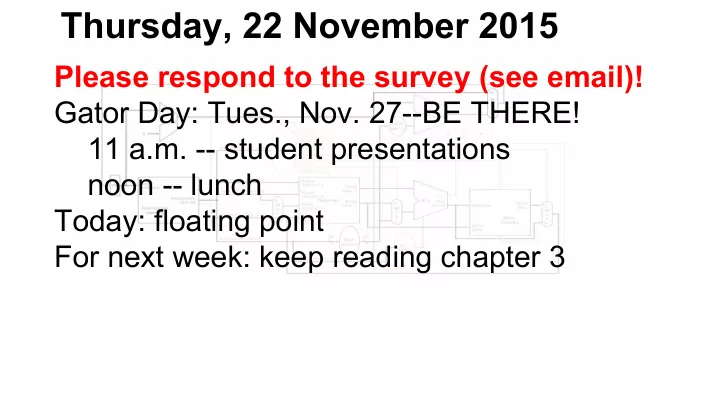

Thursday, 22 November 2015 Please respond to the survey (see email)! Gator Day: Tues., Nov. 27--BE THERE! 11 a.m. -- student presentations noon -- lunch Today: floating point For next week: keep reading chapter 3
Floating Point How do we represent fractional values in binary? Recall: Base 2 -- each position from right to left is a power of 2, starting with 2 0 = 1: 1001011 1x2 6 + 1x2 3 + 1x2 1 + 1x2 0 = 64 + 8 + 2 + 1 = 75
Floating Point The same pattern continues to the right of the decimal point (“binary point”?): High school algebra: 2 -k = 1 1001011.01101 2 k 0x2 -1 + 1x2 -2 + 1x2 -3 + 0x2 -4 +1x2 -5 = 0 + .25 + .125 + 0 + .03125 The entire thing, in decimal, is 75.40625.
Decimal Fraction to Binary Fraction To convert a decimal integer to binary, we repeatedly divided by 2 and took remainders (see notes from 17 September). To convert a decimal fraction to binary, we repeatedly multiply and take (whole number) product. Thus, .01101 .40625 x 2 = 0 .81250 (product = 0 ) .8125 x 2 = 1 .625 (product = 1 ) .625 x 2 = 1 .25 (product = 1 ) .25 x 2 = 0 .5 (product = 0 ) .5 x 2 = 1 .0 (product = 1 )
Decimal to Binary Example Let’s put it all together into a single example. Convert 3.675: 3 % 2 = 1 (3/2=)1 % 2 = 1 11.101 .675 x 2 = 1 .25 (product = 1 ) .25 x 2 = 0 .5 (product = 0 ) .5 x 2 = 1 .0 (product = 1 )
Scientific Notation From your high school science courses you probably are familiar with “scientific notation”: 388291.83 = 3.8829183 x 10 5 0.0003228 = 3.228 x 10 -4 3.14159 = 3.14159 x 10 0 We’ve used it already in this class, e.g., a nanosecond is .000000001 sec = 1x10 -9 sec, a megabyte is 1000000 bytes = 1x10 6 bytes.
Floating Point Floating point is just scientific notation, but in binary rather than decimal. Thus, 10110.10011 = 1.011010011 x 2 4 0.0001011 = 1.011 x 2 -4 1.11001 = 1.11001 x 2 0 NOTE : You CAN NOT just translate the base 10 scientific notation into binary floating point! 5.5 x 10 0 is not 101.1 x 2 0 , but 1.011 x 2 2
Floating Point Precision is the number of significant bits (or significant decimal digits--definitions vary) in a floating point number. Many fractions that have finite decimal representations have infinitely- long binary representations, so we can keep only a limited number of bits. One-tenth (0.1 ten ) is such a number: 0.1 ten = .00011001100110011001100… two
32-bit Floating Point -17 ten = 1 .0001 x 2 4 Leading “1” bit is never included ... 1 1 0 0 0 0 0 1 1 0 0 0 1 0 0 0 0 fraction sign exponent + 127 (23 bits) (1 bit) (8 bits) 4 + 127 = 10000011
32-bit Floating Point (MARS tool)
Recommend
More recommend